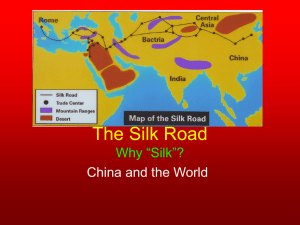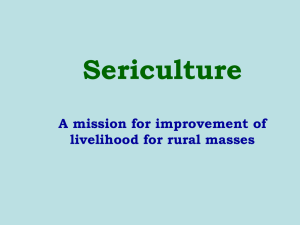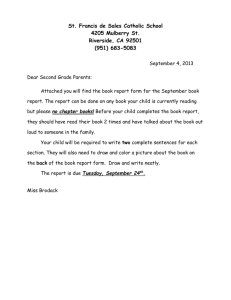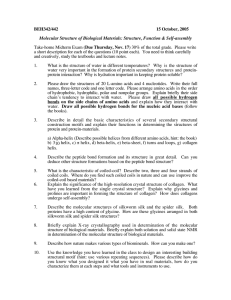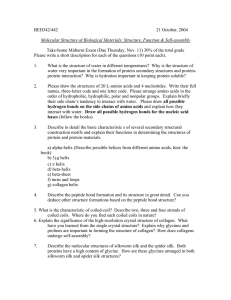Syllabus for B.Sc. Sericulture (Semester pattern)
advertisement
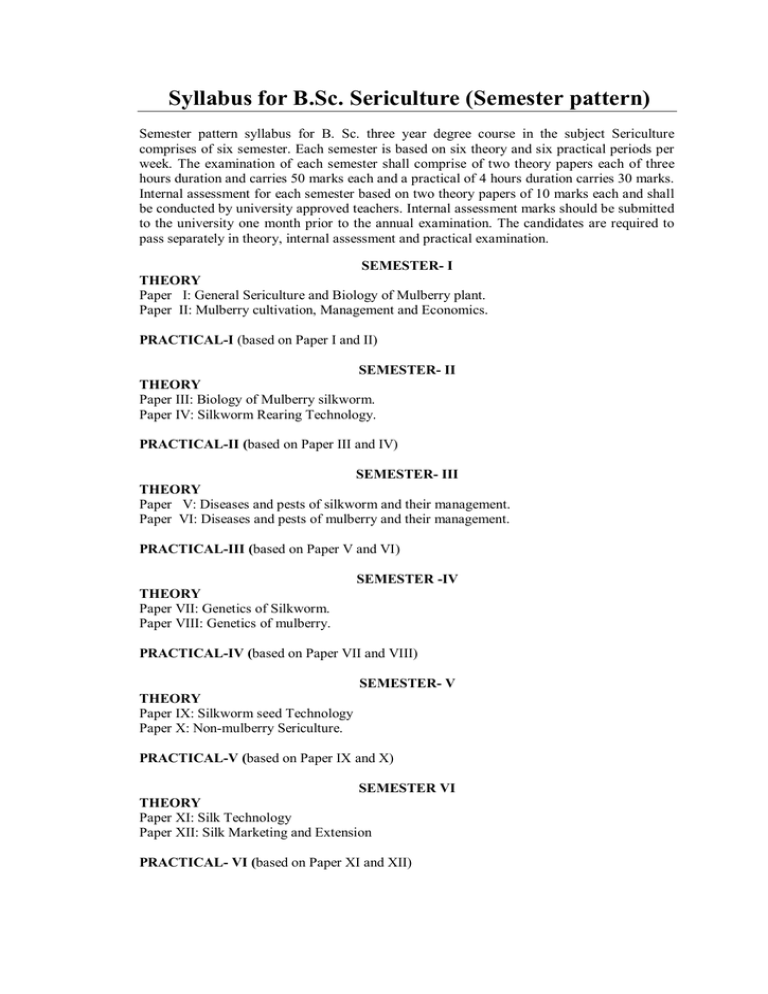
Syllabus for B.Sc. Sericulture (Semester pattern) Semester pattern syllabus for B. Sc. three year degree course in the subject Sericulture comprises of six semester. Each semester is based on six theory and six practical periods per week. The examination of each semester shall comprise of two theory papers each of three hours duration and carries 50 marks each and a practical of 4 hours duration carries 30 marks. Internal assessment for each semester based on two theory papers of 10 marks each and shall be conducted by university approved teachers. Internal assessment marks should be submitted to the university one month prior to the annual examination. The candidates are required to pass separately in theory, internal assessment and practical examination. SEMESTER- I THEORY Paper I: General Sericulture and Biology of Mulberry plant. Paper II: Mulberry cultivation, Management and Economics. PRACTICAL-I (based on Paper I and II) SEMESTER- II THEORY Paper III: Biology of Mulberry silkworm. Paper IV: Silkworm Rearing Technology. PRACTICAL-II (based on Paper III and IV) SEMESTER- III THEORY Paper V: Diseases and pests of silkworm and their management. Paper VI: Diseases and pests of mulberry and their management. PRACTICAL-III (based on Paper V and VI) SEMESTER -IV THEORY Paper VII: Genetics of Silkworm. Paper VIII: Genetics of mulberry. PRACTICAL-IV (based on Paper VII and VIII) SEMESTER- V THEORY Paper IX: Silkworm seed Technology Paper X: Non-mulberry Sericulture. PRACTICAL-V (based on Paper IX and X) SEMESTER VI THEORY Paper XI: Silk Technology Paper XII: Silk Marketing and Extension PRACTICAL- VI (based on Paper XI and XII) Semester-I PAPER-I: GENERAL SERICULTURE AND BIOLOGY OF MULBERRY PLANT Unit-I : Introduction (9 periods) 1. Sericulture : Definition, history and present status. 2. Silkworms : Types of silkworms, their food plants and distribution. 3. Silk production : Mulberry and non-mulberry cocoon and yarn 4. Prospectus of Sericulture in India : Sericulture industry in different states, employment, potential in mulberry and non-mulberry sericulture. Unit-II: Sericulture Centres (9 periods) 1. Research training and extension. 2. Seed production, reeling, re-reeling, twisting, doubling, weaving, processing and trading centres. 3. Central Silk Board (CSB) : Role in Extension and development. 4. Directorate of Sericulture: Extension and development in sericulture on state level. Unit-III : Mulberry plant morphology (9 periods) 1. Mulberry species : Classification, distribution and common varieties used in Sericulture in India. 2. Vegetative morphology : Characters of root, stem, bud and leaf. 3. Anatomy : Root, stem and leaf. 4. Reproductive morphology : Male and female reproductive organs, pollination, fertilization and development of seed, structure of seed and fruit. Unit –IV: Propagation of mulberry plant (9 periods) 1 Sowing: Seed-sowing, growth and development of mulberry saplings, dormancy period of seed. 2 Saplings : Selection, preparation and pit systems. 3 Plantation methods : Row and Pit systems 4 Mulberry leaves : Chemical composition and their nutritional value PAPER II: MULBERRY CULTIVATION, MANAGEMENT AND ECONOMICS. Unit –I : Requirement for Mulberry Cultivation 1. Soil : Physical and chemical properties 2. Soil nature : Acid soil, saline soil, calcareous soil, eroded soil 3. Soil water : Soil moisture, water requirements. 4. Climatic conditions : Temperature, photoperiod, humidity and rainfall (9 periods) Unit-II: Mulberry management (9 periods) 1. Land preparation: Soil, Levelling and ploughing. 2. Irrigation: Drip irrigation, Sprinkler irrigation, flood irrigation drainage, weeding 3. Manuring : Organic, inorganic, biofertilizer. 4 Profitable cultivation: Proper selection of the land, selection of proper varieties of mulberry, regular manuring, weeding and irrigation and disease control. Unit III: Mulberry Cultivation and Harvesting (9 periods) 1. Pruning : Bottom pruning, middle pruning and repeated pruning. 2 Harvesting : Various methods—leaf picking, shoot-leaf harvesting, branch cutting. 3 Leaf storage : Wooden leaf chamber, transportation and preservation 4 Leaf yield : Estimation of leaf yield per unit area-acre/hectare Unit-IV: Economics (9 periods) 1. Irrigated Cultivation cost : Cost of mulberry cultivation per unit area under irrigated condition. 2. Non-irrigated cultivation cost : Cost of mulberry cultivation under rain fed condition. 3. Temperate region cultivation : Cost of mulberry cultivation in temperate region. 4. Cost-benefit ratio : Cost-benefit ratio of mulberry cultivation in local region per unit area. PRACTICAL-I 1. Maps and records : a) Preparation of a map showing extension of sericulture in the world. b) Preparation of a map showing extension of sericulture in India. c) Graphical representation of cocoon and silk production by various silkworms in India. d) Graphical representation of earning from indigenous market and export of silk goods. e) Preparation of the record of mulberry cultivation, pruning and management within a year. f) Preparation of the record of silkworm culture and cocoon production within a year. 2. Moriculture : a) Soil sampling and analysis of pH and moisture content. b) External morphology of root, stem and leaf. c) Internal morphology of root, stem and leaf. d) Reproductive morphology—Inflorescence, flower, male and female reproductive parts. e) Study of histological slides of anthers, ovules and seed. f) Methods of propagation by cutting. DISTRBUTION OF MARKS 1. 2. 3. 4. 5. 6. Permanent preparation of anatomy of plant structures (Draw well labeled diagram) Identification and characteristics of mulberry varieties (Draw well labeled diagram) Soil analysis (Test reports) Stomatal frequency of different varieties of mulberry leaf Viva voce Class record 05 marks 05 marks 05 marks 05 marks 05 marks 05 marks --------------Total 30 marks ----------------------------------------------------------------------------------------------------------------- SEMESTER- II PAPER- III: BIOLOGY OF MULBERRY SILKWORM Unit-III : Silkworm taxonomy and distribution (9 periods) 1. Classification and Taxonomic characters : Phylum, class, order, family, genus and species.. 2. Moultinism and voltinism : Univoltine, bivoltine and multivoltine races. 3. Distribution and Races :.: Geographical distribution in the world and India and Exotic and indigenous races 4. Life cycle : Egg, larvae, pupa and adult, life span and bionomics, circadian rhythm and behavior and growth rate. Unit-II : Morphology (9 periods) 1. Egg : External and internal morphology and colour change. 2. Larvae : Mouth parts, legs, prolegs, spircles, eyes, claspers and integumentary hair and sexual markings. 3. Pupa : Male and Female Morphology and sexual dimorphism 4. Adult : Mouth parts, antenna, wings, external genitalia. Unit-III : Anatomy of physiology (9 periods) 1. Digestive system : Alimentary canal and physiology of digestion. 2. Silk glands : Structure, development and mechanism of silk synthesis. 3. Circulatory system : Dorsal vessel, haemolymph and haemocytes. 4. Reproductive system : Male and female systems, mechanism of egg development. Unit-IV: Endocrine and Exocrine glands (9 periods) 1. Endocrine system : Endocrine glands in lava and pupa and synthesis of hormone. 2. Hormonal control: on metamorphosis, dipause, silk synthesis and reproduction. 3. Exocrine glands : Struture, morphology and secretion of exocrine glands. 4. Pheromone: sex attractants and their role in mating. PAPER IV: SILKWORM REARING TECHNOLOGY Unit-I : Silkworm rearing house and appliances (9 periods) 1. Rearing house : Construction of ideal rearing house at suitable site and of suitable size, representing CSB model. 2. Early age rearing appliances : Rearing appliances for early age rearing 3. Late age rearing appliances: Rearing trays, ant-wells, rearing stands and racks, paraffin papers, rubber foam pads, net, chopsticks and feathers. 4. Mountages : Bamboo, plastic, nylon, Spectronic 20, Balances (Digital). Unit –II: Disinfectants and feeding appliances (9 periods) 1 Disinfect ants : Formalin, bleaching powder, RKO, 2 Disinfectant appliances: Sprayers and dusters. 3. Feeding appliances : Leaf chambers, chopping knife and chopping board. 4. Humidity and Temperature control devices : Humidifiers, thermostats, heaters, hygrometers, and conditioners, incubator and BOD incubator, Blowers. Unit-III : Silkworm rearing technology (Early age rearing) (9 periods) 1. Commercial races : Multivoltine, bivoltine and hybrid races used in India. 2. Seed : Collection of disease-free layings (DFLs), cards, loose eggs, incubation. 3. Hatching and Brushing: Uniform hatching and Brushing methods for I instar larvae 4. Rearing of Early instars (Chowki rearing). : Feeding and rearing of I, II and III instar larvae Unit-IV: Late age rearing (9 periods) 1. Rearing of Late instars: Rearing, spacing, feeding, cleaning and dusting, rearing methods. 2. Mounting and cocoon production: Types of mountages, transfer of matured silkworms, spinning of cocoons. 3. Harvesting and storage of cocoons: Harvesting, preservation, assessment, storage 4. Transportation: Cocoons, record maintenance, cost of cocoon production, leafcocoon ratio. PRACTICAL-II Silkworm biology : a) Morphology- Egg, last instar larva, pupa, adult, sexual dimorphism, mouthparts, antennae, legs, prolegs, wings. b) Anatomy-Dissection of alimentary canal, silk gland of larva and reproductive system of adult. c) Preparation of total haemocyte count (THC). d) Study of appliances—Types of trays and racks, types of mountages, humidity and temperature devices, dusters and sprayers. e) Silk products—Silk wastes, spun yarn, noil yarn and other byproducts. f) Visit to various sericulture centres. DISTRIBUTION OF MARKS ----------------------------------------------------------------------------------------------------------------1. Dissection (draw a well-labelled diagram) 05 marks 2. Temporary preparation of mouth parts of larva (draw a well-labelled diagram) 05 marks 3. Spotting (10 points) 10 marks i. 3 spots of worm structures ii. 3 spots Rearing appliances iii. 1 spot sexual dimorphism of larva/adult iv. 1 spots of life stages v. 1 spot of multi/bivoltine cocoons. 4. Viva voce 05 marks 5. Class record 05 marks --------------------Total marks : 30 marks ----------------------------------------------------------------------------------------BOOKS RECOMMENDED: 1. Text Book of Tropical Sericulture. Publ., Japan Overseas Corporation volunteers – 1975. 2. Silkworm Genetics illustrated by Tada Yokoyama. 3. Tasar culture. Dr. M. S. Jolly et. al., CSB, 1974. 4. Silkworm Rearing Techniques in the Tropics, Dr. S. Omura, Japan International Cooperation Agency, 1980. 5. Muga Silk Industry by S. N. Choudhary, Directorate of Sericulture and weaving, Govt. of Assam, 1982. 6. The natures and property of soils (9th edition) N. C. Brady (Mac Millan pub. Co. Inc., New York. 7. Studies on soils of India, S. V. Govind Rajan and H. G. Gopala Rao (1970), Vikas Publ. House Pvt. Ltd., New Delhi. 8. Text books of Soil Sciences, T. D. Biswas and S. K. Mukherjee (1990). Tata-McGraw Hill Pub. Co. Ltd., New Delhi. 9. FAO Manuals- I Mulberry cultivation. FAO Rome. 10. Boraiah, G. (1986) Mulberry Cultivation. Lectures on Sericulture. 11. Strickberger, M.W. 1976. Genetics, McMillan Publ. New York. 12. CSB, 1990. Genes and genotypes in the Germplasm bank a report of the committee for the fixation of norms. 13. Dandin et al., 1988 Bibliography on Mulberry (1900-1984) CSR & TI, (Central Silk board), Mysore. 14. Manual on Sericulture; Food and Agriculture Organisation Rome 1976. 15. Appropriate Sericultural Techniques Ed, by M. S. Jolly Director, CSR & TI, Mysore. 16. Handbook of Practical Sericulture : S.R. Ullal and M.N. Narasimhanna CSB, Bangalore 1987. 17. Handbook of Silkworm Rearing : Agriculture and Technical Manual-1, Fuzi Pub. Co. Ltd., Tokyo, Japan1972. 18. Manual of Silkworm Egg Production: M. N. Narasimhanna, CSB, Bangalore 1988. 19. Silkworm Rearing: Wupang—Chun and Chen Da-Chung, Pub. By FAO, Rome 1988. 20. A Guide for Bivoltine Sericulture: K. Sengupta, Director, CSR & TI, Mysore 1989. 21. Improved Method of Rearing Young age silkworm: S. Krishnaswamy, reprinted CSB, Bangalore, 1986. 22. The Principle of Insect Physiology: V. B. Wigglesworth: Pub. By English Language Book Soc., Chapman & Hall. 1972. 23. Economics of Sericulture under Irrigated Conditions: M.S. Jolly, CSR & TI, Mysore, 1982. 24. Silk from grub to Glamour: Mahesh M. Nanavathy, Pub. In Indian Paramount House, Bombay, 1965. 25. Principles of Insect Morphology: R. E. Snodgrass, Tata McGraw-Hill, Pub. Co., Ltd., Bombay, 1935. 26. China Sericulture, 1972, FAO, Rome. 27. Cytoplasmic, Polyhedrosis Virus of the Silkworm, Hissa Aruga and Tanada, Y, 1971, Univ. of Tokyo Press Japan. 28. Mulberry cultivation (Vol. I) written by Zheng Ting-xing, Tan Yun-fang, Huang Guangxian and Ma ben. Published by: Oxford and IBH publishing Co. Pvt.Ltd., New Delhi, Bombay, Calcutta. 29. Silk egg productions (Vol. III) written by Wang Sang-ming Published by : Oxford and IBH Publishing Co. Pvt. Ltd., New Delhi, Bombay, Calcutta. 30. The Romance of Textile, E. Lewis, MacMillan and C., Canada. 31. Insect Hormones, by U.J.A. Novak. Methuen and C., Canada. 32. Economics of Silk Industry, R. C. Rawlley, P. S. King and Sons Ltd., London. 33. Manual on Sericulture Silkworm Rearing, Krishnaswamy, S., Narasimhanna, M. N., Suryanarayan, S. K.. Kumar Raj S., FAO Agricultural Services Bulletin, AGS, ASB, Rome. 34. Silk Production, Processing and Marketing: M. M. Nanavaty, V. S. Johari, Wiley Estern Ltd., Ansari Road, Dariyaganj, New Delhi. 35. Textiles (Fiber to Fabric): Bernard P. Corbman, Gregg Division : Mc Graw-Hill Book Company, New Delhi. 36. Principles of Sericulture: Hisao Aruga, Mohan Primlani for Oxford and IBH Publishing Co. Pvt. Ltd., 66, Janpath, New Delhi-110001. 37. Modern Entomology: D. B. Tembhare, Himalaya Publishing House, Bombay. SEMESTER-III PAPER-V: DISEASES AND PESTS OF SILKWORM AND MANAGEMENT Unit-I : Basic concepts of silkworm diseases 1. Varieties of silkworm diseases, etiology 2. Pathogenesis of diseases. 3. Influence of environment and nutrition on the incidence of diseases. 4. Resistance of silkworm to diseases. (9 periods) Unit-II : Viral and Protozoan diseases (Etiology, Structure, Symptoms , (9 periods) Lessions, Pathogenesis). 1. Nuclear polyhydrosis virus (NPV) and Cytoplasmic, polyhydrosis virus (CPV) 2. Infectious flacherie virus (FV) and Densonucleosis virus (DNV). 3. Preventive measures and control of viral diseases 4 Noesma bombycis (Pebrine disease) and Preventive measures Unit-III : Bacterial diseases (Etiology, Structure, Symptoms, Lessions, Pathogenesis) 1. Bacterial septicemia (Bacillus sp. And Serriate marcenscens). 2. Bacterial gastroenteric disease (Streptococcus sp.) 3. Bacterial toxicosis (Bacillus thuringiensis) 4. Preventive measures and control of bacterial diseases (9 periods) Unit IV: Fungal Diseases (Etiology, Structure, Symptoms, Lessions, (9 periods) Pathogenesis) and Pests of Silkworms 1. Fungal diseases—white muscardine (Beauveria bassiana), Green muscardine (Nomuraea rilevi), Yellow muscardine (Isaria farinose) and Aspergillosis. 2 Preventive measures and control of fungal diseases. 3 Silkworm pests—Tachinid Fly (Uzifly) Trycholgza bombycis, Dermistid beetles, Dermestes cadniverinus—Biology, nature of damage and control. 4 Vertebrate and other silkworm pests and their control. PAPER VI: : DISEASES AND PESTS OF MULBERRY AND MANAGEMENT Unit I: 1 2 3 4 Basic concepts of Mulberry diseases Varieties of mulberry diseases, etiology Pathogenesis of diseases. Influence of environment and nutrition on the incidence of diseases. Resistance varieties to mulberry diseases (9 periods) Unit-II: Fugal and Bacterial Mulberry diseases (factors, symptoms, disease cycle and control measures) 1. Mulberry powdery mildew (fungal disease). 2. Red rust and leaf spot (fungal diseases) 3. Mulberry Wilt—Mulberry bacterial Wilt. 4. Mechanical and Chemical control of the diseases (9 periods) Unit –III Nematode and mycoplasm Diseases of Mulberry (factors, symptoms, disease cycle and control measures) 1. Mulberry root-knot and mulberry root rot (Nematode diseases) 2 Common mulberry dwarf—Mycoplasm and viral mulberry disease. 3 Mineral deficiency diseases (N, P, K, Ca, Mg, S) 4 Mechanical and Chemical control of the diseases (9 periods) Unit –IV : Pests of mulberry (Classification, Biology, Nature of damage (9 periods) and control measures) 1 Caterpillars—Bihar hairy caterpillar, Diacrisia obliqua, Semilooper, Apochemia cinareus. 2. Bugs—Leafhoppers, Emposca flavescens and Scale insects, Maconellicuccus hirsutus. 3. Beetles—Girdle beetle, Stenias grisator, Powder pest beetle, and Sinoxylon pubens. 4. Other pests- Thrips, white flies, Gall midges, mites and Grasshoppers PRACTICAL-III Pests and Diseases of Silkworm and Mulberry a. Microscopic preparation of pebrine causative agents in larva and adult by Giemsa staining method. b. Microscopic preparation of grasserie causative agents in the larva. c. Identification of flacherie and muscardine symptoms. d. Collection of mulberry disease sample and preservation. e. Preparation of fungicide formulations. f. Microscoipic preparation of mulberry fungi, viruses and bacteria causing diseases. DISTRIBUTION OF MARKS ----------------------------------------------------------------------------------------------------------------1. Temporary micropreparation of pathogen 05 marks (Identification and comment) 2. Permanent Staining of pathogen (Identification and comment) 05 marks 3. Spotting (10 spots) 10 marks vi. 2 spots of silkworm diseases (Fungal and Viral) vii. 2 spots silkworm diseases (Bacterial and Protozoan) viii. 2 spot silkworm pests ix. 2 spots mulberry diseases x. 2 spot of mulberry pests 4. Viva voce 05 marks 5. Class record 05 marks --------------------Total marks: 30 marks ---------------------------------------------------------------------------------------------------------------- SEMESTER IV PAPER-VII: GENETICS AND BREEDING OF SILKWORM Unit-I: Mendelism and quantitative genetics (9 periods) 1. Monohybrid and dihybrid cross 2. Laws of inheritance 3. Back cross ratio and test cross ratio 4. Three-way cross and double cross hybrids 5. Unit-II: Silkworm heredity and environment (9 periods) 1 Quantitative inheritance 2 Genetics of cocoon colour. 3 Heredity traits of egg, larva, cocoon, pupa and adult characters. 4 Types of linkage, linkage groups, linkage map, E-alleles and multiple alleles. Unit- III: Inheritance and Sex determination (9 periods) 1. Inheritance of voltinism and moultinism. 2. Determination of sex—system of sex chromosomes role of W and Z chromosome, sex linked and sex limited traits. 3. Chromosome, polyploidy, pathogenesis, gynogenesis and androgenesis. 4. Induction of mutation by radiation and chemical mutagenes and economic utility. Unit-IV : Silkworm breeding (9periods) 1. Silkworm breeding —Tropical and temperate races, advantages and disadvantages. 2. Heterosis, utilization of heterosis in sericulture. 3. In-breeding and out-breeding, homozygasity, autosexing, economic advantages. 4. Maintenance of silkworm races and large-scale multiplication. PAPER-VIII : GENETICS AND BREEDING OF MULBERRY Unit-I : Mulberry genetics (9 periods) 1. Genetic viability in Mulberry—Wild, hybrid, indigenous and exotic species and chromosomal variation. 2. Inheritance of mulberry and large-scale multiplication. 3. Genetic consequences of self-and cross-pollination. 4. Genetic control of disease resistance Unit-II : Mulberry breeding (9 periods) 1. Principles of plant breeding 2. Pure line, clonal and mass selection—Application, advantages and limitations. 3. Hybridization—Procedure, application, heterosis, selection in F 1 progeny, advantages and limitations. 4. Specific breeding—Drought resistant varieties. Unit –III: Mulberry Germplasm (9 periods) 1 Evaluation of mulberry genotypes—Primary, secondary and multi-locational traits. 2 Germplasm conservation—Methods, centres of collection and significance 3 Role of tissue culture in the improvement of mulberry—Methods, advantages and limitations. 4 Polyploidy and its application. Unit IV: Mulberry diversity 1. 2. 3. 4. (9 periods) Biological diversity in mulberry. Spontaneous and induced mutation. Repairs of DNA Linkage and crossing over PRACTICAL-IV Genetics and Breeding of Silkworm and Mulberry a. Squash preparation of chromosome from larval testis. b. Identification of sex linked traits in egg, larva and cocoon. c. Determination of quantitative traits—Fecundity, larva weight, larval duration, cocoon weight, shell weight and shell ratio. d. Morpohological variations of Exotic and Indigenous varieties of Mulberry. e. Demonstration of chromosomes—Root tip/pollen mother cells. f. Determination of a number of frequencies of stomata and stomatal chloroplast. g. Morphological variability in diploid, triploid, tetraploids and mutants. DISTRIBUTION OF MARKS ----------------------------------------------------------------------------------------------------------------1. Temporary micropreparation (Chromosome) (Identification and Comments). 05 2. Morphological characteristics and Identification of different Mulberry Varieties. 05 3 Spotting (5 spots) identification and comments 10 i. 2 spots from silkworms ii. 2 spots from plant materials iii. 1 spot from cocoons 4 Viva voce 05 5 Class Record 05 --------------Total Marks 30 ----------------------------------------------------------------------------------------------------------------BOOKS RECOMMENDED: 1. Silkworm Rearing and Disease of Silkworm, 1956, Ptd. By Director of Ptg., Stn. & Pub.Govt.Press Bangalore. 2. Cytoplasmic Polyhedrosis Virus of the silkworm, Hissa Aruga and Tanda ,Y, 1971, Uni. Of Tokyo Press, Japan. 3. Handbook of Pests of Disease of Mulberry and Silkworm (1990) pub., by UNESCAP, Bangkok, Thailand. 4. Disease and Pests of mulberry and their control (1991) pub., by Director, C.S. R. and T.I., Mysore. 5. Ayyar, T.V.R. (1987) Handbook of economic entomology for South India, Pub., by International books and periodical supply service, New Delhi. 6. Bindra, O. S. and Singh, H. (1980) Pesticide –Application equipment. Oxford and IBM Pub., Co., New Delhi. 7. Silkworm Disease (Vol IV) Written By: LU Yun – Lian, Translated By: LiuFu- an, Published by: Oxford and IBH publishing Co. Pvt. Ltd. New Delhi, Bombay, Calcutta. 8. Allard, R.W. (1960) Principles of plant Breeding: John Willey and Sons, Inc., New York. 9. Chandrashekharan S. N. and Parthasarthy S. V. (1960) Cytogenetic and Plant Breeding: Varadachary and Co. Madras. 10. Sengupta K. and Dandni S.B. (1989) Genetic resources of mulberry and utilization. CSR and TI, Mysore. 11. Street, H.E. (1977) Plant tissue and cell culture; Blackwell, London. 12. IAEA (1974) Polyploidy and induced mutations in plant breeding; International Atomic Energy Agency, Veinna. 13. Kiraly, Z et al. (1974) Methods in plant pathology with special references of to breeding for Disease resistance (Eds.) Kiraly J. Elsevier Sci., Publ. Co., New York. 14. FAO Manual – Mulberry Cultivation, FAO, Rome. 15. Boraiah (1986) Mulberry Cultivation. Lectures on Sericulture. 16. Streckberger, M. W. (1976) Genetics, Macmillan Pub. , Co. Inc. New York. 17. Genes and Genotypes in the germplasm bank -1990 (a report of the committee for the fixation of norms) Central Silk Board, Bangalore. 18. Falconer, D. S. (1972) Introduction to quantitative genetics. Oliver and Boyd, Edinburgh. 19. Tazima, Y. (1964) Genetics of Sikworm, Academic Press, London. 20. Kovalev, P. A. (1970) Silkworm Breeding Stocks –CSB, Mumbai. 21. Reinert, J. and Bajaj,Y. P. S. eds. (1977) Plant cell, Tissue and Organ Culture, Springer vrlag, Berlin – Heidlberg. 22. Sinha, U. and Sinha S. (1976) Cytogenetics, Plant Breeding and Evolution, Vikas Pub.House Pvt. Ltd., New Delhi. 23. The Silkworm Biology, Genetics and Breeding By Dilip De Sarkar, Vikas Publishing House Pvt. Ltd., New Delhi. 24. Sturnikov ,V. A. (1976) Control of Silkworm development and Sex MIR publishers., Moscow. 25. Tazima, Y. (1978) The Silkworm : An important laboratory toll, Kodansha Limited,Tokyo. SEMESTER- V PAPER-IX: SILKWORM SEED TECHNOLOGY Unit- I : Principles of Seed technology: (9 periods) 1. General Principles : Silkworm seed, production, demand trends and seed legislation Act. 2. Seed organization : Maintenance of parental stock, monitoring of seed crop-screening of egg shells, larvae, faecal matter for disease, disinfection and maintenance of hygiene. 3. Seed cocoons : Production, selection—pupal examination and certification of seed cocoons criteria of price fixation, procurements 4. Transportation, preservation and sex separation. Unit-II : Grainage equipments and management : (9 periods) 1. Grainages : Plan of model grainages—infrastructure, cold storage, facility and equipment, maintenance of grainage conditions. 2. Grainage management: Staff component, labour maintenance of grainage good cocoons, laying ration. 3. Distribution of eggs: precautions and preventive measures 4. Protective measure and maintenance of records ion grainage. Unit-III : Seed production : (9 periods) 1. Eclosion of moths: Synchronization of emergence of moth, collection and selection, coupling, decoupling and storage of male moth. 2. Egg laying : Ideal condition for egg laying, methods of egg laying, disinfection of eggs and packing of egg cards. 3. Mother moth examination for disease infection: Types of examination, green moth and dry moth examination, individual and mass examination. 4. Precautions during moth examination. Unit-IV: Handling and Preservation of eggs (9 periods) 1 Handling of bivoltine eggs : Physical and chemical methods for early hatching hot and cold acid treatments. 2 Advantages and disadvantages of hot and cold acid treatments. 3 Handling of multivoltine eggs : Preservation of ..................hatching—ideal embryonic stages for cold storage, duration of cold storing. 4. Economics of seed production : Cost benefit ration in relation to man-power equipment and maintenance. PAPER- X: NON-MULBERRY SERICULTURE Unit-I : Tasar Culture (Biology and Rearing) (9 periods) 1. Tropical tasar : Distribution, life cycle, morphology of egg, larva, pupa, cocoon, moth larval behavior. 2. Anatomy : Silk gland, digestive, respiratory, reproductive system in larva and moth. 3. Food plants : Primary and secondary food plants, distribution, taxonomy, morphology, propagation and plantation. 4. Rearing : Rearing operations—brushing, maintenance of larval population, improved rearing techniques for young and late age tasar. Unit-II: Grainage (Seed production) (9 periods) 1 Seed cocoons : Procurement—cocoons of different ecotypes, preservation of cocoons, synchronization of moth emergence, production of disease-free egg layings. 2 Diseases and pests : Types, incidences, preventive and control measures. 3 Breeding : Character of the ecoraces, selection and hybridization. 4 Genetics : Inheritance of larval body colour, cocoon colour, moth colour and chromosome number. Unit-III : Tasar Silkworm (Taxonomy, Biochemistry and Reeling) (9 periods) 1 Taxonomic aspects of Antherea : Imprints of egg shell, setae, wing venation pigments, phytohormones. 2 Silk reeling and spinning : Chemical composition of haemolymph, enzymes, sex attractants, pigments, phytohormones. 3 Silk reeling and spinning : Sorting, shifting, reeling—methods, appliances, modified reeling machine, reeling machines. 4 Temperature tasar : Fauna, distribution, food plant and rearing. Unit-IV : Muga and Eri culture (Biology, Rearing and silk production) (9 periods) 1. Muga silkworm: Distribution, Food plants and Life cycle, Rearing, Brushing, traditional and improved methods. 2. Muga silk reeling: Stifling, degumming and reeling 3. Eri Silkworm: Distribution, life cycle and food plants, Rearing of eri silkworm, Brushing, feeding, moulting and care, cocooning, mounting and harvesting. 4. Spinning of cocoons: stifling, degumming, spinning appliances—band spinning, takli, charkha, spinning machines and marketing. PRACTICAL-V Seed Technology and Non-mulberry Sericulture a) Plan of grainage building and grainage equipment—Visit to the commercial grainage, visit to the seed cocoon markets, commercial, multivoltine and bivoltine. b) Processing of seed cocoons – deflossing—sorting—selection of good cocoons, Assessment of seed cocoons—pupal examination. c) Cutting of seed cocoons—Sex separation by pupal method—preservation of cocoon/pupa, maintenance of temperature, humidity and light factors. d) Emergence of moths—Selection of moths—pairing and depairing. Oviposition, Preservation of mate moths. e) Mother moth examination—Individual and mass, whole and sampling method surface sterilization of silkworm eggs. f) Sheet eggs and loose egg preparation—Preparation of starch coated paper, washing of loose eggs, Drying-Treatment of eggs with acid-Weighing and packing. g) Acid treatment of bivoltine eggs. Hot acid treatment. h) Dissection of silkworm eggs of different stages—Staining method—Observation of embryonic development in relation to preservation of eggs at different low temperature (chilling and hibernating eggs). i) Morphological studies of food plants of non-mulberry silkworm viz., T. tomentosa, T. arjuna, R. communis (castor) with reference to taxonomic traits. j) Morphology of egg, larva, pupa, cocoon and moths of Antheria mylitta (tasar silkworm) Different ecotypes of Antheria mylitta. k) Rearing appliances used in rearing and seed preparation of non-mulberry silkworms (Drawings and sketches). l) Determination of physical and commercial characters of cocoon study of different reeling and sinning machines (drawings), identification of different types of yarn, spun silks and wastes. DISTRIBUTION OF MARKS ----------------------------------------------------------------------------------------------------------------1. Dissection of larva of non mulberry silkworm 10 marks (Draw a well-labeled diagram) 2 Temporary preparation of embryonic stages of silkworm eggs/ 05 marks Mother moth examination 3 Spotting (05 spots) 05 marks i 1 spots of grainage equipment ii 1 spots of non mulberry plants iii 1 spot sexual dimorphism of larva/adult iv 1 spots of life stages v 1 spot of multi/bivoltine cocoons. 4 Viva voce 05 marks 5 Class record 05 marks --------------------Total marks: 30 marks ---------------------------------------------------------------------------------------------------------------- SEMESTER VI PAPER-XI: SILK TECHNOLOGY Unit-I : Selection of Cocoon for reeling (9 periods) 1. Evolution of silk reeling industry and its present status. 2. Quality of cocoon : Cocoon shell ratio, cocoon shell reeling rate, silk filament length, cocoon reelability, factors affecting reelability. 3. Physical and chemical properties of silk fibre. 4. Raw materials for silk reeling : Selection of cocoon for reeling. Assessment of renditta, cocoon gradation, cocoon procurement and transportation. Unit-II: Cocoon processing (9 periods) 1 Cocoon drying: Different methods, conventional and modern techniques steam stifling, hot air dryer, sun drying and others, advantages and disadvantages. 2 Cocoon sorting and preservation: Separation of defective cocoons, deflossing, methods of storing and preservation of cocoons. 3 Cocoon cooking: Principles of cocoon cooking, 4 Cocoon cooking equipment and brushing: open pan, three pan boiling methods, cocoon brushing hand and mechanical brushing. Unit-III : Raw silk manufacture (Reeling and re-reeling)) (9 periods) 1 Reeling appliances: Concept of silk reeling, Country charkha, Domestic machine, Cottage machine, Multi-end reeling machine, Automatic machine. 2 Reeling operations : Formation of reeling end, jettebout, croissure, reels, speed of reels, traverse or distributors. 3 Re-reeling : Re-reeling machine, lacing, denier, skeining, booking and storage. 4 Water quality and silk reeling : Use of water in silk reeling, water quality, relationship between water quality and silk reeling, water quality standards. Unit-IV : Silk throwing and Weaving : (9 periods) 1. Raw silk testing and grading : Methods of testing, standard testing appliances and equipment methods of grading of raw silk. 2. Silk throwing and twisting : Throwing preparation for twisting, Twisting of yarn, soaking, dressing, drying, winding, doubling and twisting. 3. Silk weaving : Warping, beaming, drawing denting, weft preparation, power loom and handloom weaving. 4. Chemical processing of silk yarns and fabrics : Degumming, bleaching, dyeing, printing of silk yarns and fabrics. Silk byproducts : Reeling waste and its utility in spun silk industry utility of pupae PAPER XII: MARKETING AND EXTENSION Unit-I : Extension (9 periods) 1. Principles and importance of extension education in sericulture. 2. Extension training in India and its role in rural development. 3. Methods of sericulture extension: Direct group and mass contact methods. 4. Role of Central Silk Board and Directorate of Sericulture in extension Unit-II: Sericulture Organization and Management: (9 periods) 1. Sericulture organization at state and national levels : Development, research, training and policies. 2. Role of National Silkworm Seed Organization in grainage 3. Sericulture services network : Basic seed facility, seed areas, grainages, nurseries, Central Research Centres (CRCs), filature, silk exchanges and cocoon certification centres. 4. Project formulation and role of credit co-operative and financing agencies in sericulture: NAARD, IDBI, Banks, IRDP, etc. Unit-III : Marketing organizations (9 periods) 1. Sericulture marketing organization for seed cocoon, raw silk and silk fabric 2. Traditional and regulated markets, their merits and limitations. 3. Government intervention: Legislation and implication in marketing. 4. Marketing institutions: Marketing boards, co-operatives and stabilization of price. Unit IV: Cocoon and Yarn Marketing (9 periods) 1 Cocoon Marketing: Gradation of seed and reeling cocoons, marketing of multivoltine bivoltine and hybrid cocoons. 2 Yarn marketing: Gradation of yarn, twisted/untwisted yarn 3 Feedback system: Surveys—types, merits and limitations. 4 Silk export: Challenges and growth prospects. PRACTICAL-VI Silk technology, marketing and extension: a) Identification of Textile fibres by physical and chemical tests—microscopic examinations, flame test and solubility test for polyester, cotton, silk. b) Identification of defective cocoons and their percentage in a lot, determination of shell ratio of good cocoon. c) Single cocoon reeling—determination of average filament length and denier . d) Practical demonstration of cooking, reeling and re-reeling of a sample cocoon. e) Practical demonstration of multi-end silk reeling machine. f) Study of silk fabric manufacturing unit power loom and handloom (visit to spun silk mill) during on the training. DISTRIBUTION OF MARKS ----------------------------------------------------------------------------------------------------------------1. Physical and chemical testing of fibre 05 marks 2. Determination of shell ratio/reeling of single cocoons 05 marks 3. Demonstration of cocoon cooking and reeling 10 marks 4. Viva voce 05 marks 5. Class record 05 marks --------------------Total marks : 30 marks --------------------------------------------------------------------------------------------------------------BOOKS RECOMMENDED: 1. Narasingabba, M. N. (1988) Manual of silkworm and its production by Central Silk Board, Bangalore. 2. Manjula, A. and H. K. Hurakadli (1985) Cold Acid treatment for Bivoltine Silkworm eggs for Tropical countries, Indian Journal of Sericulture 26;25-99. 3. Manula. A. (1991) A scientific methods of incubating the silkworm eggs-Indian Silk 30 (8):7-14. 4. Wang San –ming (1994) Silkworm egg production, Volume III published by Oxford & IBH publishing co. Pvt. Ltd. New Delhi. 5. Datta. R. K., Basavaraja H. K. and Mano, Y. (1996) Manual on Bivoltine Rearing Race maintenance and Multiplication published by CSR and TI, Mysore. 6. Saheb, N. M. B., Sengupta, K. Reddy, G. V. A. Tretise on the Acid Treatment of silkworm eggs by CSR & TI, Mysore. 7. Manual of Sericulture, FAO.Volume 4. 8. Muga Sericulture, S. N. Choudhary. 9. Ericulture, S. N. Choudhary. 10. Tasar Culture, M. S. Jolly and others Ambika pub., Bombay. 11. Handbook of Muga Culture, K.Thangevalu & ME. Isa. 12. Ericulture in India .D.C. Sarkar Published by C.S.B.Banglore. 13. FAO Manual of Sericulture,. Volume III. 14. Raw Silk reeling –B. H. Kim. 15. Silk Biology, Chemistry, Technology- Paolo Carbonic 16. Silk reeling technique tropic-S. omorh. 17. Silk dyeing, printing and finishing –Gularajani. 18. Silk production, processing and marketing –Mahesh N. Nanavaty. 19. Silk Production and weaving in India. C.C. Ghosh. 20. Silk Industry Problem and Prospect- A. Ajas H. Lawpper. 21. Weaving Calculation –Surpaum 22. Silk Reeling –Haung Guo Rui –Published by Oxford & IBH Publishing Co. Pvt. Ltd. New Delhi. 23. Nanavathy. M. 1965. Silk from group to glamour. 24. Ramana ,D.V. 1987 Economics of Sericulture and Silk Industry in India, Deep and Deep publisher, New Delhi. 25. Sinha, S. V. 1960. The Development of India Silk –A wealth of opportunities. 26. Supe, S.V. An introduction to extension education. 27. Advi Reddy –Extension Education 28. Dhamo ,O. P. and Bhatnagar. O.P. Education and Communication for Development. 29. Regers E.M. and Shoewalkar, 1960 Diffusion of innovation. 30. Anonymous 1992. Silkman‘s Companion ,C.S.B. publication, Bangalore.

